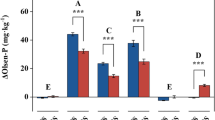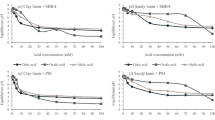Abstract
The reactivity of 11 phosphate rocks (PRs), both in their finely ground and unground forms, and containing up to 12% of CaCO3 were estimated from the P extracted with 2% citric acid, 2% formic acid and neutral ammonium citrate. With the neutral ammonium citrate, PRs were also extracted sequentially. To determine the relative agronomic effectiveness (RAE) of PRs a greenhouse experiment was conducted using three soils of different P retention, and growing ryegrass as the test plant. PRs were applied at three rates plus control. Ground Sechura PR was employed as the standard PR and single superphosphate was included to determine maximum dry matter production. Three cuts of ryegrass were taken over 4 months in 2 soils, and 8 cuts over 10 months in one soil. RAE of the PRs was calculated from dry matter yields obtained at a fertiliser P rate where superphosphate gave 90% of the maximum attainable yield, and also from the yield and P uptake values averaged over rates of application.
Amount of P extracted by the different reagents correlated closely with each other (R2 0.82–0.99). Chemical extractable P integrated the effect of particle size as well as the inherent chemical reactivity of PRs. Formic P expanded the scale and thus was the most sensitive indicator to rank PRs. The ranking of PRs were similar between soils. RAEs between soils correlated significantly (R2 = 0.88–0.91). For predicting the agronomic potential of PRs, RAEs calculated from 4 cuts of ryegrass over 4 months appeared to be as good as those calculated from 8 cuts, over 10 months.
The total P of PRs was smaller in the large and very small size fractions than in the intermediate ones. With unground rocks the extractable P decreased with increasing particle size mainly due to their decreasing specific surface area. Practical implications of these results are discussed. Extractable P did not decline with increasing total P in the different size fractions of PRs. End-over-end shakers, unlike wrist-action shakers, gave consistent extractable P values.
Formic-P was the best predictor of the agronomic effectiveness of PRs even when the data from ground and unground PRs, and from 3 soils of differing P retention were treated as one population (R2 = 0.87–0.92).
Similar content being viewed by others
References
Anderson DL, Kussow WR and Corey RB (1985) Phosphate rock dissolution in soil. Indication from plant growth studies. Soil Sci Soc Am J 49: 918–925
AOAC (1980) Official methods of analysis (13th edn). Association of Official Analytical Chemists, Washington DC, Sec 2.042
Barrow NJ (1985) Comparing the effectiveness of fertilisers. Fert Res 8: 85–90
Basson WD (1976) Nitrogen and phosphorus determinations in animal feeds on a continuous flow system. Lab Prac 25, 763–765
Braithwaite AC, Eaton AC and Groom PS (1989) Some factors associated with the use of the extractants 2% citric acid and 2% formic acid as estimators of available phosphorus in fertiliser products. Fert Res 19: 175–181
Chapman DH and Pratt PF (1961) Methods of analysis for soils, plants and water. University of California, Div of Agri Sciences, Riverside, California, USA
Chien SH and Hammond LL (1978) A comparison of various laboratory methods for predicting the agronomic potential of phosphate rocks for direct application. Soil Sci Soc Am J 42: 935–939
Evans L (1979) Multiple extractions of Phosphates.New Zealand Fertiliser Manufacturers' Research Association Research Report. pp 256–267
Gregg PEH, Mackay AD, Currie LD and Syers JK (1988) Application strategies for Sechura phosphate rock use on permanent pasture. Fertiliser Research 17: 219–234
Hagin J, Reinhorn T and Axelrod S (1978) Comparison of finely ground phosphate rocks as P sources to plants. Seminar on phosphate rock for direct application. Haifa, Israel pp 246–264
Higgins DH and Braithwaite AC (1990) The determination of phosphate availability for some less conventional phosphate fertilisers. Fert Res 26: 271–280
Kucey RM and Bole JB (1984) Availability of phosphorus from 17 rock phosphates in moderately and weakly acidic soils as determined by32P dilution, A value, and total P uptake method. Soil Sci 138: 180–188
Leon LA, Fenster WE and Hammond LL (1986) Agronomic potential of eleven phosphate rocks from Brazil, Columbia, Peru and Venezuela. Soil Sci Soc Am J 50: 798–802
McClellan GH (1978) Mineralogy and reactivity of phosphate rock. Seminar on phosphate rock for direct application. Haifa, Israel pp 57–81
Mackay AD, Brown MW, Currie LD, Hedley MJ, Tillman RW and White RE (1990) Effect of shaking procedures on the neutral ammonium citrate soluble phosphate fraction in fertiliser materials. J Sci Food Agric 50: 443–457
Mackay AD, Syers JK and Gregg PEH (1984) Ability of chemical extraction procedures to predict the agronomic effectiveness of phosphate rock materials. NZ J Agric Res 27: 219–230
Mishra B, Kumar P and Divedi GK (1985) Effectiveness of Indian rock phosphates in acid soils. J Indian Soc Soil Sci 33: 574–580
Morel CH and Fordeau JC (1989) Native soil and fresh fertiliser phosphorus uptake as affected by rate of application and P fertilisers. Plant and Soil 115: 123–128
Murphy J and Riley JP (1962) A modified single solution method for the determination of phosphate in natural waters. Anal chim Acta 27: 31–36
Olsen RA (1975) Rate of dissolution of phosphate from minerals and soils. Soil Sci Soc of Am Proc 39: 634–639
Rajan SSS, Fox RL, Saunders WMH and Upsdell M (1991) Influence of pH time and level of application on phosphate rock dissolution and availability to pastures. I. Agronomic effectiveness. Fert Res 28: 85–93
Sinclair AG and Dyson CB (1988) An interim report on the MAF ‘National Series’ forms of phosphate fertiliser trials. MAFTech, Ministry of Agriculture and Fisheries, Wellington, New Zealand pp 1–100
Syers JK, Mackay AD, Brown MW and Currie LD (1986) Chemical and physical characteristics of phosphate rock materials of varying reactivity. J Sci Food Agric 37: 1057–1064
Upsdell MP (1985) ‘Bayesian inferences for functions’. PhD thesis, Nottingham University, UK
Watkinson JH (1989) Measurement of the oxidation rate of elemental sulphur in soil. Aust J Soil Res 27: 365–375
Author information
Authors and Affiliations
Rights and permissions
About this article
Cite this article
Rajan, S.S.S., Brown, M.W., Boyes, M.K. et al. Extractable phosphorus to predict agronomic effectiveness of ground and unground phosphate rocks. Fertilizer Research 32, 291–302 (1992). https://doi.org/10.1007/BF01050366
Received:
Accepted:
Issue Date:
DOI: https://doi.org/10.1007/BF01050366




